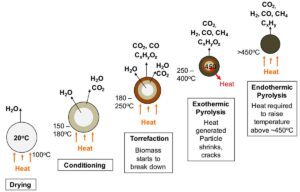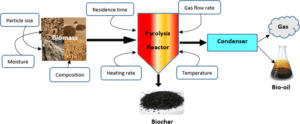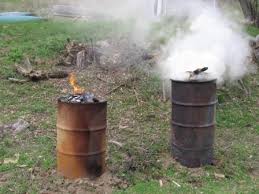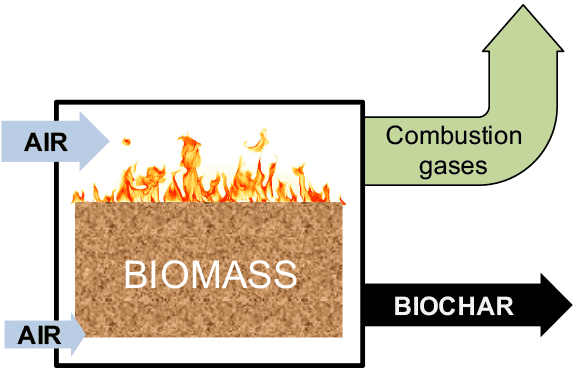Sustainable Energy and Economic Growth
- Biomass carbonization, a process that converts organic material into charcoal or biochar through controlled heating, has gained attention as a sustainable, practical approach to energy production and waste management in rural areas.
- In these regions, where traditional sources of energy like firewood are widely used but contribute to deforestation and pollution, biomass carbonization offers a promising alternative. By converting agricultural waste, forest residues, and other organic materials into valuable carbon-rich products, rural communities can access cleaner energy sources, enhance soil health, and develop new economic opportunities.
- This blog post explores the wide-reaching potential of the biomass carbonization process in rural areas, examining its environmental, economic, and social impacts

What is Biomass Carbonization?
- Biomass carbonization involves heating organic materials in a low-oxygen environment, transforming them into charcoal, biochar, or syngas (synthetic gas).
- This process is sometimes referred to as pyrolysis and typically requires temperatures between 300°C and 800°C.
- The end products of carbonization vary based on the specific technique used and the feedstock materials. Key byproducts of this process include:
-
- Biochar: A stable form of carbon that can be applied to soil, improving water retention, nutrient availability, and microbial activity.
- Charcoal: A fuel source for cooking and heating, offering a cleaner, longer-burning option than raw firewood.
- Syngas: A mixture of gases produced during the carbonization process, which can be captured and used as an alternative fuel for various applications.

biochar-production-process-steps
- This process is essential for creating sustainable fuel alternatives and agricultural soil enhancers, and it has applications in energy production, waste management, and environmental preservation.
The Basics of Biomass Carbonization
- At its core, biomass carbonization is a form of pyrolysis, which means breaking down organic material at high temperatures in the absence of oxygen.
- The temperatures typically range from 300°C to 800°C. The lack of oxygen prevents the material from combusting, instead decomposing it into carbon-based products and gases.
- The key products resulting from carbonization include:
- Biochar: A stable, carbon-rich material that enhances soil fertility.
- Charcoal: A solid fuel with a high carbon content, commonly used for cooking and heating.
- Syngas (Synthetic Gas): A gas mixture of hydrogen, carbon monoxide, and methane that can be used as an energy source.

Stages of the Carbonization Process
The carbonization process generally involves three main stages:
Dehydration Stage
In this initial stage, biomass is dried by heating it to remove moisture. This stage typically occurs below 200°C. It’s essential because any water in the biomass would interfere with the subsequent chemical reactions and reduce the efficiency of the carbonization process.
Decomposition Stage
As the temperature increases (between 200°C and 300°C), the biomass undergoes thermal decomposition. This stage releases volatile compounds, including gases like methane and carbon monoxide, as well as some condensable organic vapors. This phase also produces a small amount of charcoal.

Carbonization Stage
- At temperatures between 300°C and 800°C, the biomass material fully carbonizes, breaking down into solid carbon (charcoal or biochar) and gas byproducts. The carbon content becomes more concentrated as non-carbon elements are released as volatile gases.
- This stage produces the highest-quality charcoal or biochar, which is rich in carbon and has low reactivity.
Key Methods of Biomass Carbonization
Several carbonization methods are available, with each approach affecting the yield, quality, and properties of the end products:
Traditional Kilns
Traditional earth or brick kilns are widely used for charcoal production, particularly in rural and developing areas. While they are inexpensive and simple to build, traditional kilns lack precise control over the carbonization process and often result in lower efficiency and higher emissions.

Retort Kilns
Retort kilns offer a more controlled environment for carbonization, reducing emissions and improving yield. These kilns capture gases released during carbonization and often reuse them as fuel to sustain the process, making them more environmentally friendly and efficient than traditional kilns.
Continuous Carbonization Systems
Industrial or continuous carbonization systems are used to process large quantities of biomass efficiently. These systems maintain constant temperatures and allow for better control of the process, producing high-quality biochar or charcoal at scale. Continuous systems are often used in commercial operations and for biochar production for agricultural use.
Applications of Carbonized Biomass
The products of biomass carbonization have several key applications:
- Fuel for Cooking and Heating: Charcoal produced from carbonization burns longer and cleaner than raw firewood, making it ideal for cooking and heating, particularly in rural or off-grid areas.
- Soil Enhancement: Biochar is highly beneficial in agriculture. Its porous structure improves soil water retention, nutrient availability, and microbial health, leading to improved crop yields.
- Pollution Reduction: By using agricultural and forestry waste in carbonization, communities can reduce open-air burning, which is common in rural areas and contributes to pollution. Carbonization captures carbon in a stable form, helping sequester it and reduce greenhouse gas emissions.
- Refer Charcoal Making Methods from Biomass in Farms

The Environmental Benefits of Biomass Carbonization
- The environmental impact of biomass carbonization is significant, particularly for rural areas where sustainable practices are vital for long-term ecosystem health. Key environmental benefits include:
Reduced Deforestation
Traditional energy sources like firewood contribute to deforestation, which has negative effects on biodiversity and local climates. Biomass carbonization, however, allows rural communities to produce charcoal from renewable organic waste, reducing the demand for firewood and helping to preserve forests.
Improved Air Quality
Burning raw firewood releases high levels of pollutants, including particulate matter and carbon monoxide, which are harmful to human health. Carbonized biomass burns cleaner, producing fewer pollutants and reducing indoor air pollution — a critical health issue in many rural households that rely on open fires for cooking and heating.
Climate Change Mitigation
- One of the most notable advantages of biomass carbonization is its potential for carbon sequestration.
- Biochar, a byproduct of carbonization, can be incorporated into the soil, where it acts as a stable carbon sink for hundreds to thousands of years.
- This sequestered carbon helps mitigate climate change by reducing the amount of carbon dioxide (CO₂) in the atmosphere.
Waste Management
- Agricultural residues, forestry waste, and other organic materials often go to waste or are burned in open fields, releasing greenhouse gases and polluting the environment. Biomass carbonization offers a way to repurpose this waste into valuable resources, minimizing pollution and improving waste management in rural communities.
Economic Opportunities Through Biomass Carbonization
- In rural areas, where economic opportunities are often limited, biomass carbonization can provide an alternative source of income.
- The production of biochar, charcoal, and syngas can create jobs and stimulate small-scale industries, driving local economic growth. Here are some of the economic benefits of adopting biomass carbonization in rural settings:
Income from Charcoal and Biochar Production
Producing and selling charcoal or biochar can be a profitable venture for rural households or cooperatives. With growing demand for environmentally friendly fuel sources and soil amendments, rural producers can find markets for these products in nearby urban areas or agricultural sectors.
Job Creation and Skill Development
Establishing small-scale biomass carbonization operations can create jobs for local residents, from collecting feedstock materials to processing, packaging, and marketing the products. As these operations expand, they can also provide opportunities for skill development, helping rural workers gain experience in sustainable energy production and resource management.
Value-Added Products for Agricultural Use
- Biochar is highly valued in agriculture for its ability to improve soil health. By producing biochar locally, rural communities can provide an affordable and effective soil amendment to local farmers, helping them increase crop yields and reduce reliance on costly chemical fertilizers.
- The use of biochar can also make farming practices more sustainable, contributing to long-term agricultural productivity.
Energy Savings
- By using locally produced charcoal and syngas, rural households can reduce their spending on other fuel sources, which may be costly or difficult to access in remote areas.
- This cost savings can be reinvested in other essential needs, contributing to the overall economic well-being of rural communities.

Enhancing Soil Health and Agricultural Productivity with Biochar
One of the most exciting aspects of biomass carbonization is the production of biochar, a material with significant benefits for soil health and agriculture. Biochar has a unique porous structure that helps retain moisture, nutrients, and microorganisms, making it an ideal soil amendment for sustainable farming.
Improved Water Retention
Biochar’s porous structure allows it to hold water, which can be especially beneficial in arid or drought-prone regions. By improving soil water retention, biochar can help crops withstand dry periods, reducing the need for frequent irrigation and supporting food security in rural areas.
Enhanced Nutrient Availability
Biochar also helps retain essential nutrients, preventing them from leaching out of the soil. This increased nutrient availability can lead to better crop yields and reduce the need for synthetic fertilizers, which can be expensive and environmentally harmful.
Soil Microbial Activity
Biochar supports beneficial microbial activity, which plays a critical role in nutrient cycling and plant growth. By fostering a healthy soil ecosystem, biochar contributes to sustainable agriculture and helps rural farmers achieve higher productivity.
Long-Term Soil Health
Unlike traditional fertilizers, which need to be reapplied regularly, biochar is highly stable and remains in the soil for long periods. This longevity makes it a cost-effective, low-maintenance soil amendment for rural farmers seeking sustainable solutions.
Challenges to Biomass Carbonization in Rural Areas
While biomass carbonization holds tremendous potential, its implementation in rural areas faces several challenges that need to be addressed:
Access to Technology
Many carbonization processes require specialized equipment, which can be costly or unavailable in remote areas. To make biomass carbonization viable for rural communities, affordable, low-tech carbonization methods need to be developed and disseminated.
Lack of Technical Knowledge
Effective carbonization and biochar production require some technical expertise, and many rural residents may not have access to the necessary training. Government agencies, NGOs, and community organizations can play a vital role in providing training and resources to rural communities.
Market Access
For rural producers to benefit economically from biomass carbonization, they need access to markets where they can sell their products. Establishing reliable distribution channels and market networks will be essential for scaling biomass carbonization in rural areas.
Sustainable Feedstock Management
- Biomass carbonization requires a steady supply of feedstock, such as crop residues or wood waste.
- In areas where these resources are limited, overharvesting for carbonization could become an issue, leading to unsustainable practices.
- Implementing guidelines and monitoring systems will help ensure that carbonization remains an eco-friendly solution.
Promoting Biomass Carbonization in Rural Areas
- To unlock the full potential of biomass carbonization in rural settings, collaborative efforts among governments, NGOs, and the private sector are essential.
- Here are some ways to promote the adoption of biomass carbonization:
Policy Support and Subsidies
Government policies that support renewable energy and sustainable agriculture can incentivize rural communities to adopt biomass carbonization. Subsidies for equipment, tax incentives, and grants can make it easier for rural residents to invest in carbonization technologies.
Educational and Training Programs
Educational initiatives are vital for equipping rural communities with the skills they need to implement carbonization effectively. Training programs can cover everything from technical aspects of biochar production to best practices for soil application and market development.
Partnerships and Community-Based Models
Collaborating with NGOs, research institutions, and private companies can help rural communities gain access to technology, funding, and expertise. Community-based carbonization initiatives, such as cooperatives, can also enhance economic stability and foster a sense of shared responsibility.
Awareness Campaigns
Raising awareness about the benefits of biomass carbonization can help overcome resistance to change and encourage rural residents to adopt new technologies. Campaigns that highlight the health, economic, and environmental advantages of carbonization can make a compelling case for its adoption.
Scope of CFD modeling in carbonization process
Conclusion
- The scope of the carbonization process for biomass in rural areas is vast and promising.
- By transforming waste materials into valuable resources, carbonization offers rural communities a way to meet energy needs, improve agricultural productivity, and generate income while preserving natural resources and supporting environmental sustainability.
- The use of CFD in carbonization offers immense potential for improving process efficiency, product quality, and environmental compliance.
- By simulating the complex thermal and fluid dynamics, CFD modeling can lead to innovations in reactor design, energy use reduction, and emissions management, which are essential for scalable, sustainable carbonization in both industrial and rural applications..

